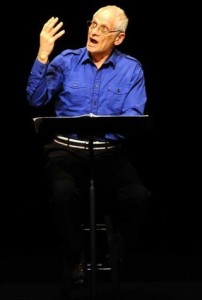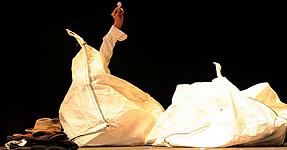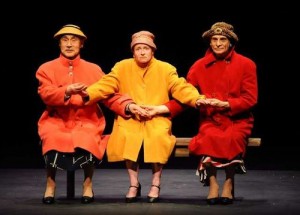PURITY IN THE THEATER:
FOUR PERFORMANCES ONLY
Pure. Perfect. Impeccable. Mesmerizing. Exquisite. Hilarious. Work of Art.
 Take your pick. Any one of these – or all of them – aptly describe Samuel Beckett’s Fragments, under the simple, elegant, finely tuned direction of Peter Brook and Marie Hélène Estienne. The experience of seeing it is akin to entering a world of dreams and waking up only when the three extraordinary actors – Yoshi Oïda, Bruce Myers, Hayley Carmichael – take their final bow. In the first of the five short pieces – “Rough for Theatre I” – an encounter between a blind man and a one-legged man becomes Waiting For Godot in miniature or, as someone pointed out to me, Laurel and Hardy in cosmic mode. Alternately funny and touching, it is quintessential Beckett, a vaudeville skit about survival in a bleak world. The second – “Rockaby” – one of the signature performances of that great Beckett interpreter, Billie Whitelaw, becomes, in the heart and body of Ms. Carmichael, transcendent; it will be a long time before I forget – if I ever do forget – the final image of her in a straight-back chair which she has transformed, through an actor’s skill, into a rocking chair. The third – “Act Without Words II” – which seems to be about nothing more (or less) than the way we live our lives from day to day and keep going despite the tedium of it all, is so playful and buoyant that daily struggle seems like uncommon fun. The fourth – “Neither” – is as lucid as it is brief. And the fifth – “Come And Go” – is sheer heaven, a droll, beautifully-lit-and-costumed charmer about three dowdy women whose close friendship is not above bringing out the worst in two of them when the third leaves them alone for a minute. The sight of the three actors – the men managing to be as feminine as the woman without a trace of winking at the audience – is the essence of what theater, at its best, is all about: the visual image as ideal complement to the written word. Laughter and tears are one in Beckett’s unique world. And not an ounce of pretension is anywhere to be found.
Take your pick. Any one of these – or all of them – aptly describe Samuel Beckett’s Fragments, under the simple, elegant, finely tuned direction of Peter Brook and Marie Hélène Estienne. The experience of seeing it is akin to entering a world of dreams and waking up only when the three extraordinary actors – Yoshi Oïda, Bruce Myers, Hayley Carmichael – take their final bow. In the first of the five short pieces – “Rough for Theatre I” – an encounter between a blind man and a one-legged man becomes Waiting For Godot in miniature or, as someone pointed out to me, Laurel and Hardy in cosmic mode. Alternately funny and touching, it is quintessential Beckett, a vaudeville skit about survival in a bleak world. The second – “Rockaby” – one of the signature performances of that great Beckett interpreter, Billie Whitelaw, becomes, in the heart and body of Ms. Carmichael, transcendent; it will be a long time before I forget – if I ever do forget – the final image of her in a straight-back chair which she has transformed, through an actor’s skill, into a rocking chair. The third – “Act Without Words II” – which seems to be about nothing more (or less) than the way we live our lives from day to day and keep going despite the tedium of it all, is so playful and buoyant that daily struggle seems like uncommon fun. The fourth – “Neither” – is as lucid as it is brief. And the fifth – “Come And Go” – is sheer heaven, a droll, beautifully-lit-and-costumed charmer about three dowdy women whose close friendship is not above bringing out the worst in two of them when the third leaves them alone for a minute. The sight of the three actors – the men managing to be as feminine as the woman without a trace of winking at the audience – is the essence of what theater, at its best, is all about: the visual image as ideal complement to the written word. Laughter and tears are one in Beckett’s unique world. And not an ounce of pretension is anywhere to be found.
And, oh yes, add Glorious to the list of words describing Fragments.
Having said that, let me add that I was shocked and dismayed by the fact that Myers read, from a script, at a lectern, complete with stage directions, The Grand Inquisitor and, despite the sheer beauty of Myers’s voice and the content of the material, there is a world of difference between a reading and a performance, and so I am providing a link to my original review in order to give a hint as to what I feel Los Angeles audiences are not seeing. What had been one of the most profound spiritual experiences I have had in a long history of theater-going was transformed into a dry, academic exercise.
At least, we have Fragments.
An Evening of Peter Brook:
Fragments and The Grand Inquisitor
The Broad Stage
1310 11th Street in Santa Monica
ends on April 10, 2011
for tickets, call 310.434.3200 or visit The Broad
Fragments
The Grand Inquisitor
Theater Review: FRAGMENTS and THE GRAND INQUISITOR (Santa Monica)
PURITY IN THE THEATER: FOUR PERFORMANCES ONLY
Pure. Perfect. Impeccable. Mesmerizing. Exquisite. Hilarious. Work of Art.
Take your pick. Any one of these – or all of them – aptly describe Samuel Beckett’s FRAGMENTS, under the simple, elegant, finely tuned direction of Peter Brook and Marie Hélène Estienne. The experience of seeing it is akin to entering a world of dreams and waking up only when the three extraordinary actors – Yoshi Oïda, Bruce Myers, Hayley Carmichael – take their final bow. In the first of the five short pieces – “Rough for Theatre I” – an encounter between a blind man and a one-legged man becomes WAITING FOR GODOT in miniature or, as someone pointed out to me, Laurel and Hardy in cosmic mode. Alternately funny and touching, it is quintessential Beckett, a vaudeville skit about survival in a bleak world. The second – “Rockaby” – one of the signature performances of that great Beckett interpreter, Billie Whitelaw, becomes, in the heart and body of Ms. Carmichael, transcendent; it will be a long time before I forget – if I ever do forget – the final image of her in a straight-back chair which she has transformed, through an actor’s skill, into a rocking chair. The third – “Act Without Words II” – which seems to be about nothing more (or less) than the way we live our lives from day to day and keep going despite the tedium of it all, is so playful and buoyant that daily struggle seems like uncommon fun. The fourth – “Neither” – is as lucid as it is brief. And the fifth – “Come And Go” – is sheer heaven, a droll, beautifully-lit-and-costumed charmer about three dowdy women whose close friendship is not above bringing out the worst in two of them when the third leaves them alone for a minute. The sight of the three actors – the men managing to be as feminine as the woman without a trace of winking at the audience – is the essence of what theater, at its best, is all about: the visual image as ideal complement to the written word. Laughter and tears are one in Beckett’s unique world. And not an ounce of pretension is anywhere to be found.
And, oh yes, add Glorious to the list of words describing FRAGMENTS.
Having said that, let me add that I was shocked and dismayed by the fact that Myers read, from a script, at a lectern, complete with stage directions, THE GRAND INQUISITOR and, despite the sheer beauty of Myers’s voice and the content of the material, there is a world of difference between a reading and a performance, and so I am providing XXXXX a link to my original review XXXXX in order to give a hint as to what I feel Los Angeles audiences are not seeing. What had been one of the most profound spiritual experiences I have had in a long history of theater-going was transformed into a dry, academic exercise.
At least, we have FRAGMENTS.
harveyperr @ stageandcinema.com
FRAGMENTS and THE GRAND INQUISITOR
scheduled to close April 10 at time of publication
for tickets, visit http://thebroadstage.com/


